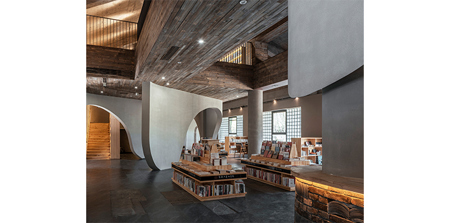

Grand Canal Bookstore, Beijing
EDO ARCHITECTS
The existing building has a densely arranged column grid, with five rows of columns spanning north to south and a depth of four bays, similar to the double-axis column grid of traditional architecture. Moreover, the columns in the middle are excessively tall, connected by a transverse beam at an elevation of 3.9 meters from the ground, resulting in a fragmented space that is unsuitable for use as a reception center or bookshop. To overcome the constraints of the existing column grid, the design team proposed the concept of "flowing walls." Curved partition walls are employed to link up the column grid, and the dynamic links between columns dissolve their visual impact, giving rise to an irregular yet cohesive spatial form. Arch-shaped openings are carved on the sinuous walls to bridge previously separated spaces and create relatively indistinct boundary divisions. In this manner, the flowing walls not only unify the space but also introduce "transparency" between different areas, constituting an interconnected and mutually visible spatial system. This approach is akin to implanting a free-form garden space structure into a rigid, double-axis plane reminiscent of traditional Chinese architecture, endowing the interior with the allure of transition, connection, and nature engagement.